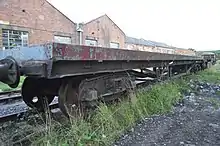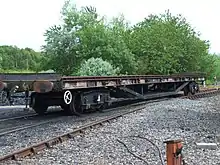Bogie bolster wagon
A bogie bolster wagon is a British railway term for a long goods wagon with a flat bed and no sides or roof. They are used for carrying long flat loads, usually loaded by crane and then tied down.

Design


A bogie bolster has both bogies and bolsters.
Bogies are four-wheeled, articulated carriages beneath the main load bed. They allow a long wagon to carry long loads, but still have individually short wheelbases, and so go round tight corners.
Bolsters are baulks of timber fixed across the bed. The bed is thus not flat, but most loads such as girders, rails, timber lengths, signal posts etc. are stiff enough that they only need to be supported at intervals, not continuously across a flat planked bed. The space between baulks allows room for tie-down chains or lifting strops, making this bolster design easier to work with than a completely flat bed.
Bolsters could be fixed in place, or be removable. Some had as many as five bolsters.[1] Some designs had multiple sockets and a pair of bolsters could be moved between them. The bolsters could even be allowed to swivel around a central locating pin, and curved steel rubbing strips on the wagon deck.[1] The design of bogie bolster wagons had developed from earlier timber wagons: these were short four-wheeled wagons, each carrying a single swivelling bolster.[2] A pair of such wagons could carry a large treetrunk to a sawmill, but they required either the tree to take the full tension of the train[lower-roman 1] or for a suitable number of match wagons to be marshalled between the two bolster wagons. The long, but relatively lightweight, bogie bolster replaced this with a single wagon.
Most designs also had 'stakes', removable vertical steel bars to retain a load from rolling or sliding sideways. These could be either fixed through the bolsters, or inserted into pockets along the edge girders of the wagon body.[lower-roman 2]
Bolster wagons are relatively lightweight. Heavier well wagon, for machinery loads, had deeper and stronger side girders. They had a cranked profile from the side, so that the load's centre of gravity was carried lower. Bogie bolsters could carry typical loads of 15 or 30 tons.[3]
The GWR telegraphic code word for a bogie bolster was 'Macaw'.[4] Other codes for specific types were 'Beaver' or 'Gane'.
Rail wagons
Bogie bolsters were particularly useful for permanent way loads, such as rail. Many such wagons were not part of the railway's commercial stock, but were included as part of departmental stock (stock used for engineering works on the railway itself).
Codes for these wagons included 'Salmon', Bobol[5] and 'Gane'[4]
A number of bogie bolsters have been preserved on British heritage railways, as they are convenient for moving rails, telegraph poles and other permanent way loads.[5][6]
See also
References
- This was sometimes done on narrow-gauge forestry railways
- See the 'Gane A' illustration for visible, but empty, pockets
- Hooper, John (1991). Wagons on the LNER: North British. Irwell Press. pp. 58–59, 79, 96. ISBN 1-871608-22-8.CS1 maint: ref=harv (link)
- Hooper (1991), pp. 80–81.
- Hooper (1991), p. 96.
- "Code Names for Great Western Carriage Stock and Vans". The Great Western Archive. 2013.
- "42 ton Bogie Bolster 'D' Wagon № B942667". Northampton & Lamport Railway.
- "FRT buys only known remaining FR wagon". Furness Railway Trust.